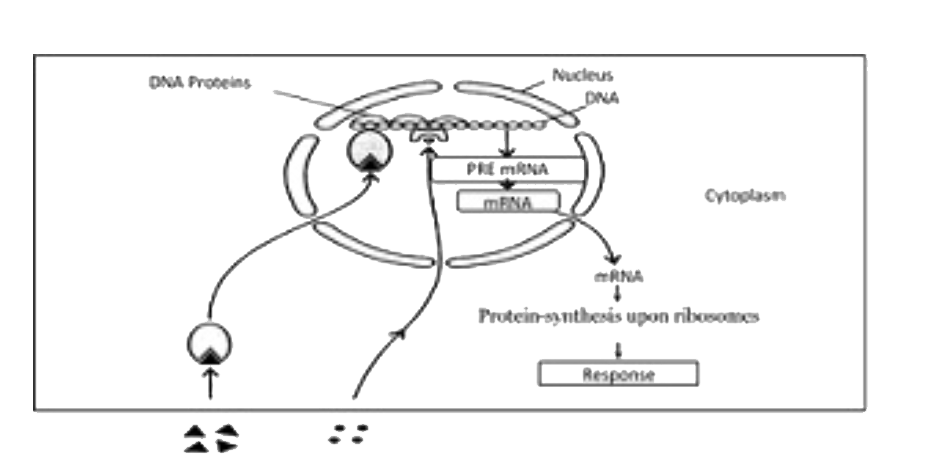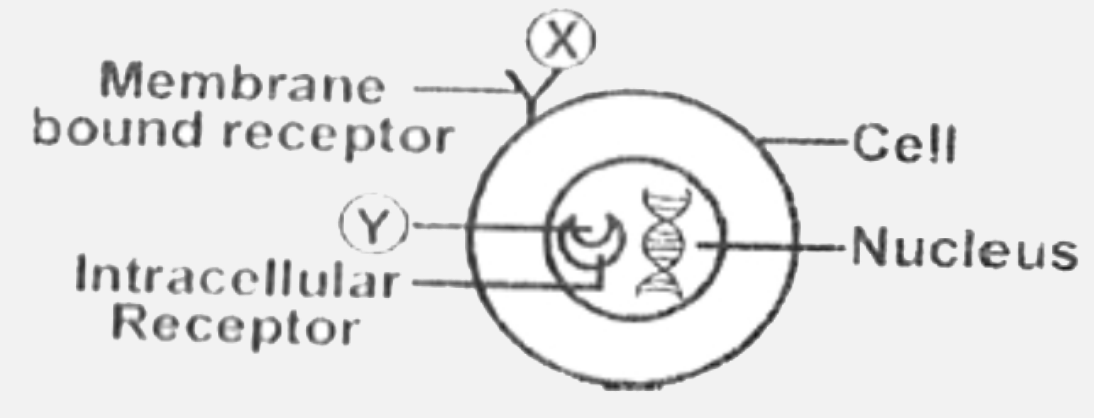Generation of second messengers is not possible in which of the given set of hormones ?
Epinephrine, insulin glucagon
Estrogen, cortisol, thyroxine
FSH, LH, oxytocin
Estradiol, oxytocin, FSH
The correct Answer is:B
To solve the question regarding which set of hormones does not generate second messengers, we can follow these steps:
1. Understand Hormone Types:
- Hormones can be classified based on their chemical nature into different categories: peptide hormones, steroid hormones, iodothyronines, and amino acid derivatives.
2. Identify Receptor Types:
- Hormones bind to receptors on target cells, which can be either membrane-bound receptors or intracellular receptors.
- Membrane-bound receptors typically lead to the production of second messengers (e.g., cAMP, IP3).
- Intracellular receptors do not produce second messengers.
3. Analyze the Given Hormones:
- Option 1: Epinephrine, Insulin, and Glucagon
- All are peptide hormones and bind to membrane receptors, thus they generate second messengers.
- Option 2: Estrogen, Cortisol, and Thyroxine
- Estrogen and Cortisol are steroid hormones, and Thyroxine is an iodothyronine. All three bind to intracellular receptors and do not generate second messengers.
- Option 3: FSH, LH, and Oxytocin
- FSH and LH are peptide hormones, and Oxytocin is also a peptide hormone. Therefore, they generate second messengers.
- Option 4: Not provided in the transcript, but we can conclude based on the analysis.
4. Conclusion:
- The correct answer is Option 2: Estrogen, Cortisol, and Thyroxine, as these hormones do not generate second messengers due to their binding to intracellular receptors.
Final Answer:
The generation of second messengers is not possible in the set of hormones: Estrogen, Cortisol, and Thyroxine.
- Hormones can be classified based on their chemical nature into different categories: peptide hormones, steroid hormones, iodothyronines, and amino acid derivatives.
- Hormones bind to receptors on target cells, which can be either membrane-bound receptors or intracellular receptors.
- Membrane-bound receptors typically lead to the production of second messengers (e.g., cAMP, IP3).
- Intracellular receptors do not produce second messengers.
- Option 1: Epinephrine, Insulin, and Glucagon
- All are peptide hormones and bind to membrane receptors, thus they generate second messengers.
- Option 2: Estrogen, Cortisol, and Thyroxine
- Estrogen and Cortisol are steroid hormones, and Thyroxine is an iodothyronine. All three bind to intracellular receptors and do not generate second messengers.
- Option 3: FSH, LH, and Oxytocin
- FSH and LH are peptide hormones, and Oxytocin is also a peptide hormone. Therefore, they generate second messengers.
- Option 4: Not provided in the transcript, but we can conclude based on the analysis.
- The correct answer is Option 2: Estrogen, Cortisol, and Thyroxine, as these hormones do not generate second messengers due to their binding to intracellular receptors.
The generation of second messengers is not possible in the set of hormones: Estrogen, Cortisol, and Thyroxine.
Similar Questions
Second messenger is
View SolutionThe name secondary messenger is given to
View SolutionRead the following statements.
(I) Ketonuria and glycosuria are characteristic symptoms of diabetes insipidus.
(II) Gynecomastia is caused due to alteration in estrogen to androgen ratio.
(III) Except renin all other component of RAAS are produced by kidneys.
(IV) Generation of secondary messengers leads to the amplification of response generated for a hormone molecule.
Choose the option which includes correct statements only.View SolutionWhat is the role of second messenger in hormone action ?
View SolutionThe diagram given below is related to which of the following set of hormones ?
 View Solution
View SolutionWhat is the role of second messenger in the mechanism of protein hormone action?
View SolutionIdentity the set of hormone releasing IUD?
View SolutionSecond messengers are activated in response to
View SolutionThe set of hormones which lead to the formation of secondary messengers like cyclic AMP during their mode of action is:
View SolutionGiven below is a schematic representation of the mechanism of hormone action. Select the set of hormones which can bind with Y.
 View Solution
View Solution

